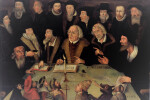Heidelberg Catechism

We are all familiar with Martin Luther’s nailing of the 95 Thesis to the door of Wittenberg Chapel on October 31,1517. His boldness touched off a theological firestorm in Germany, and resulted in the formation of the Lutheran Church. We also know of John Calvin’s ministry in Geneva and the fact that his theological writings and views contributed greatly to the development of the Reformed Churches. Both of these churches had a powerful influence on Europe by advancing that great rediscovery of the gospel we now know as the Protestant Reformation. However, as we celebrate Reformation Day, I want to briefly consider a lesser-known aspect of that great revival, whose impact reverberates down to the present day.
Heidelberg was a key city of the Holy Roman Empire and the capital of the Lower Palatinate, one of the many principalities that made up the Empire. Although small, the Palatinate was very important because its count was one of the seven rulers who elected the Emperor. Hence, Count Palatine bore the title of Elector.
The Reformation came early to the Palatinate when, in 1518, Martin Luther was invited to a debate at the prestigious university in Heidelberg. Luther did not bode well at the hands of his Roman Catholic opponents, but his teaching opened the door for the winds of reformation to blow through the principality. Though persecuted and oppressed by the decrees of the Emperor, Protestant preaching and teaching survived in the Palatinate.
However, theological controversy soon raised its head. The Palatinate was strongly influenced by both the Lutheran and the Reformed traditions, and these two strongly disagreed about the proper interpretation of communion. Most Lutherans insisted the body of Christ was physically present in the bread and wine, while the Reformed tended to follow Calvin’s view that Christ was spiritually present – a true presence embraced by faith.
The controversy raged so strongly that Elector Frederick III was only able to quiet the church by banishing several advocates from both sides. He then recruited Caspar Olevianus, a student of Calvin, as pastor of the high church and Zacharius Ursinus, who had studied under the moderate Lutheran Philip Melanchthon, to teach theology in the university. The Elector then commissioned and supervised the writing of a new catechism for the gospel education of the people of his domain. We know it as the Heidelberg Catechism.
Published in 1563 (nearly 100 years before the Westminster Confession and Shorter Catechism), the Heidelberg Catechism became one of the most widely accepted statements of Reformed doctrine in Europe. Out of the heat of controversy, Olevianus and Ursinus (along with several others) produced a doctrinally accurate summary of the Christian faith that also encouraged a deeply personal embrace of the gospel. Beloved by many generations of believers, the Heidelberg Catechism became one of the Three Forms of Unity (along with the Belgic Confession and the Canons of Dort) embraced by the continental Reformed Churches.
~Pastor Steere


Comments
Login/Register to leave a comment